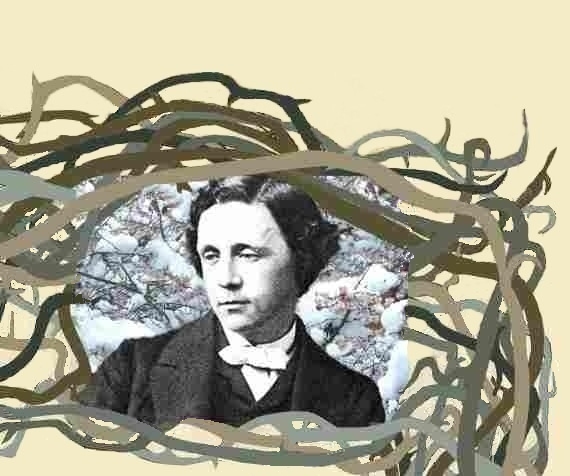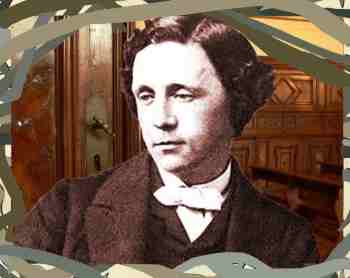CHARITIES AND FUNDS SUPPORTED BY LEWIS CARROLL
From "Lewis Carroll in his Own Account" by Jenny Woolf
The Rev. Charles L. Dodgson ("Lewis Carroll") supported many charities with regular payments, usually on or about the 1 January each year. He must have reviewed this list each year, as it varied somewhat from year to year. The payments, in total, were a significant proportion of his income.
His bank account also shows a number of contributions to special "one-off" funds, listed below with the date of the payment.
Sums are given in pounds (£) shillings and pence: £5.10.6 would mean five pounds, 10 shillings and six pence. There are 20 shillings to the pound, and 12 pence to the shilling. To get an idea of present-day equivalent value, multiply by around fifty.
1. CHARITIES
- The Associate Institution for Improving and Enforcing the Laws for the Protection of Women (usually referred to in the Account as "Prot. of Women"). This charity organised the suppression of "improper houses" and financed the detection and punishment of parties who committed indecent or other assaults upon women and children. It gave vulnerable women and girls counsel and help, with a view to shielding them from the temptations and dangers to which many of them were exposed.
- The Benevolent Strangers' Friend Society, founded in 1787, aided the sick poor.
- The Bishop of London's Fund was begun in 1863 by Archibald Tate, CLD's ex-headmaster in Rugby, later Bishop of London, for the building of churches, particularly in poor areas.
- The Charity Organisation Society was set up in 1869 to improve the standard of administering charity relief, emphasising the need for self help, and accompanying it with personal care. Key members included Beatrice Webb and Octavia Hill.
- The Chelsea Hospital for Women was situated in the Kings Road, London, and specialised in female medical problems.
- The Christian Evidence Society was established in 1870 to present fundamental truths of Christianity to enquirers.
- The Church Missionary Society was founded in 1799 to spread the Gospels abroad. Their aims were to follow God in the same way as the missionaries of the early Church: humbly and on a small scale, putting money after prayer and study, and depending on the Holy Spirit.
- The Dogs' Temporary Home, established in 1860, was an animal shelter, a forerunner of the Battersea Dog's Home for abandoned dogs.
- Dr. Barnardo's Home for Orphans was founded in 1870 in Mile End, London. It expanded in the following years, opening more homes. It finally became today's "Barnardo's" children's charity.
- The Evelina Hospital was opened in Southwark in 1869, and still exists today. It was a specialist hospital to serve sick children in an area of London where disease was rife due to the poor living conditions.
- The Governesses' Benevolent Association, established 1843, provided homes and annuities for governesses left destitute or too old to work.
- Guy's Hospital, London, opened in 1726, and is still operational today.
- The Homes of Hope sheltered and helped fallen and friendless young women.
- The House of Charity for Distressed Persons was founded in 1846 by members of the Oxford Movement. It provided temporary residences for those of good character in distress. It emphasised the importance of keeping destitute families together instead of splitting them up, (as was done at that time in workhouses). It still exists today as the House of St. Barnabas in London, W.1.
- The Industrial Home for Crippled Boys was established in 1866 in Kensington, London, to offer a home and teach trades to poor handicapped boys.
- The Kyrle Society was founded in 1877 to bring aesthetic beauty into the lives of the poor by laying out parks and encouraging house-decoration, window gardening and flower growing, etc.
- The Lock Hospital, established 1746, was a specialist hospital in London for the treatment of venereal disease among low classes of society.
- The London Female Penitentiary /London Guardian Society was the female prison in Clerkenwell, London, where "betrayed" and "sincerely repentant" fallen women were rehabilitated and taught trades so they could support themselves honestly.
- The London Hospital, Whitechapel, was first established in 1740. It catered for wounded seamen, labourers and other working people of this poor district.
- The Metropolitan Association for Befriending Young Servants was founded by Mrs. Jane Senior. It aimed to befriend young girls from 13 to 20 years of age who were in or hoped to enter domestic service, and were exposed to moral dangers because of their lack of home protection. The society also trained and housed these girls when it was deemed necessary to do so.
- The Metropolitan Drinking Fountains Association provided public drinking fountains for people and public water troughs for animals. The first public fountain was erected in 1859.
- The Pure Literature Society was associated with the SPCK. It promoted the increased circulation of pure and healthy literature by selecting and selling on books of "good moral tone" to libraries, young men's associations, etc.
- Poplar Hospital for Accidents, established in 1858, was in East India Road, London, and provided casualty facilities for the poor people of the area, in particular the workers at the dockyards, where accidents were common.
- The Reformatory and Refuge Union, founded in 1856, had ninety homes throughout the country to shelter and help the fallen, destitute and neglected, particularly women and children.
- St. George's Hospital, founded in 1720, was situated near Hyde Park Corner, London.
- The SPCA, founded in 1824. The Society for the prevention of Cruelty to Animals was the forerunner of today's RSPCA.
- The Society for the Promotion of Christian Knowledge (SPCK) was founded in 1698. It was and still is a foremost publisher of religious and moral books
- The Society for the Protection of Women and Children fought against the sexual exploitation and trafficking of women and children, sometimes mounting legal prosecutions.
- The Society for the Rescue of Young Women and Children also referred to in the Account as "Soc. Rescue Fallen Women") was founded in 1853 to help avoid the dangers and ameliorate the consequences of prostitution of women and children.
- The Society for the Suppression of Mendicity was founded in 1818 for apprehending vagrants and imposters, while offering relief to the deserving poor. Subscribing members could direct begging letter writers to central office where their claims would be investigated. They would be helped if genuinely deserving.
- The Society for the Suppression of Vice was established in 1802 to suppress all outward exhibitions of vice and immorality; more especially the suppression of exhibition and sale of immoral publications, pictures, or other representations.
- The Society for the Relief of Distress, founded in 1860, offered help for anyone in distress who needed it, with no distinction of creed or race.
- The Workhouse Infirmary Nursing Association was set up in 1870 by Louisa Twining (of the tea family) to improve the standard of nursing in workhouses.
2. SPECIAL FUNDS AND CHARITABLE COLLECTIONS
- Abercarne Fund. (27.9.1878). To help victims of the colliery disaster in Abercarne, Wales. £5.0.0.
- French Rel Fd. (7.2.1871) The French Relief Fund offered assistance for French asylum seekers from the Franco-Prussian War. £5.0.0
- John Lee Fund. (12.3.84) Fund not identified. £1.0.0
- Lancashire Relief Fund. (14.11.63). The Lancashire Relief Fund assisted cotton textile workers left destitute by the Northern blockade on raw cotton imports during the American Civil War. £5.5.0
- Smallpox Fund. (19.10.1871). Not known which fund. £2.2.0.
- Tennessee Fund. (19.2.68) Fund not identified £5.5.0
- Warren Defence. (3.1.1879 and three subsequent years). Fund not identified. £1.1.0 p.a.
©Jenny Woolf 2007





